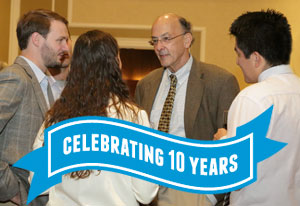Celebrating a decade of Fogarty fellows
July / August 2014 | Volume 13, Issue 4
Opinion by Fogarty Director Dr Roger I Glass

Photo by Bill Branson/NIH
Fogarty Director Dr. Roger I Glass engages with
Fogarty Fellows and Scholars.
As we mark the 10th anniversary of Fogarty's efforts to encourage medical students and young scientists to pursue a career in global health, it's a useful time for reflection. What started as a small program that sent about 20 medical students a year to a developing country for hands-on research experience has now blossomed beyond our wildest dreams.
This year, more than 80 U.S. and foreign fellows will carry out research projects in 24 low- and middle-income countries (LMICs). The initial group largely had experience in infectious diseases and joined research projects focused primarily on HIV/AIDS, malaria or tuberculosis. Now our participants run the gamut from geneticists to infectious disease docs, and from diabetologists to bioengineers.
Originally supported by a single private donation, we now enjoy funding partnerships with 17 NIH Institutes, Centers and Offices, which support worthy candidates targeting research in their areas of interest. There is broad recognition of the importance of helping us to bridge the gap between doctoral work and a solid career pathway in global health research.
The response has been extraordinary and we were delighted to expand the program a few years ago to include Fulbright and Doris Duke Foundation fellows, who join us for the weeklong orientation on the NIH campus. All the fellows have the opportunity to hear about cutting-edge work from top scientists, informally interact with NIH leaders and network with each other.
It is gratifying to see how much enthusiasm exists at all levels of training, and the growing recognition of the diversity of diseases now of global importance. I have been delighted to watch our progress - sending Malawi its first-ever pediatric cardiologist, cultivating a rheumatologist studying the link between breast cancer and osteoporosis in China and even engaging several veterinarians to study diseases that affect both humans and animals.
Many of our alumni credit their career shift to participation in this program and tell us this early exposure to global health research has inspired them to go further. A growing number have built on their early study results obtained as fellows to cultivate further funding to continue this important work.
Now, after 10 years, we can see that many who began in the initial cohort are now independent investigators, working in their fields at top research institutions where they keep an eye firmly on global health topics. Some alumni are now are engaged in mentoring the next generation of fellows. Others have gone on to establish departments of obstetrics, infectious disease, cardiology or other specialties in LMIC institutions.
Our Fogarty fellows have done such amazing things, I am always astounded when I have a chance to meet them and witness their poster presentations. This program has a powerful ability to channel the dreams and capture the imagination and aspirations of these young, idealistic students. It provides physicians and postdocs an alternative path for those who are seeking a meaningful and rewarding career in global health.
By seeding the next generation of global health leaders, we ensure we will have the capacity - at home and abroad - to tackle the complex challenges required to improve health for all people.
More Information
To view Adobe PDF files,
download current, free accessible plug-ins from Adobe's website.